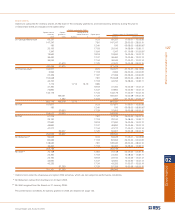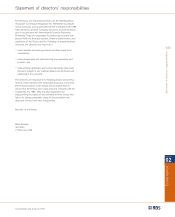RBS 2005 Annual Report Download - page 123
Download and view the complete annual report
Please find page 123 of the 2005 RBS annual report below. You can navigate through the pages in the report by either clicking on the pages listed below, or by using the keyword search tool below to find specific information within the annual report.
section
02
Governance
121
Directors’ remuneration report
Annual Report and Accounts 2005
Directors’ remuneration report
The Remuneration Committee
The members of the Remuneration Committee are Bob Scott
(Chairman), Colin Buchan, Jim Currie and Eileen Mackay,
until her retirement on 31 December 2005. All members of
the Remuneration Committee are independent non-executive
directors.
During the accounting period, the Remuneration Committee
received advice from Watson Wyatt, Mercer Human Resource
Consulting and Ernst & Young LLP on matters relating to
directors’ remuneration in the UK (Watson Wyatt and Ernst &
Young) and US (Mercer). In addition, the Remuneration
Committee has taken account of the views of the Chairman of
the Board and the Group Chief Executive on performance
assessment of the executive directors.
In addition to advising the Remuneration Committee, Watson
Wyatt provided professional services in the ordinary course of
business, including actuarial advice and benefits
administration services to subsidiaries of the Group and
investment consulting advice to The Royal Bank of Scotland
Pension Trustees Limited. Mercer Human Resource Consulting
provided advice and support in connection with a range of
benefits, pension actuarial and investment matters. Ernst &
Young provided professional services in the ordinary course of
business, including actuarial and corporate recovery advice.
Remuneration policy
The executive remuneration policy was approved by share-
holders at the company’s Annual General Meeting in 2005.
At the beginning of 2005, the Remuneration Committee
decided to conduct a comprehensive review of all aspects of
the executive remuneration package. A review of this depth
had not been undertaken since 2000/2001. Its terms of
reference were to examine all aspects of the executive
remuneration strategy, policy and practice in light of the
changing business make up and strategy of the Group and the
evolution of best practice on executive remuneration. Following
this review, the Remuneration Committee made no change to
the overall executive remuneration policy, which is set out
below. However, as a result of this review, the Group is making
a number of changes to executive director remuneration
practice which are described below.
The objective of the executive remuneration policy is to
provide, in the context of the company’s business strategy,
remuneration in form and amount which will attract, motivate
and retain high calibre executives. In order to achieve this
objective, the policy is framed around the following core
principles:
•Total rewards will be set at levels that are competitive within
the relevant market, taking each executive director’s
remuneration package as a whole.
•Total potential rewards will be earned through achievement
of demanding performance targets based on measures
consistent with shareholder interests over the short, medium
and longer-term.
•Remuneration arrangements will strike an appropriate balance
between fixed and performance-related rewards. Performance-
related elements will comprise the major part of executive
remuneration packages. See illustrative charts below.
•Incentive plans and performance metrics will be structured
to be robust through the business cycle.
•Remuneration arrangements will be designed to support the
company’s business strategy, to promote appropriate
teamwork and to conform to best practice standards.
UK-based executive directors’ remuneration balance
The above diagram has been prepared to illustrate the use of performance metrics
in the total compensation package. For the Group Chief Executive 22% of the
package is fixed and 78% is performance related. For the other executive directors,
28% is fixed and 72% is performance related. Values are entered on the basis of on
target performance; long term incentives are shown at the approximate expected
value at grant. Pension and other benefits have been excluded. Financial metrics
include profit growth, cost control and ROE.
The non-executive directors’ fees are reviewed annually by the
Board, on the recommendation of its Chairman. The level of
remuneration reflects the responsibility and time commitment of
directors and the level of fees paid to non-executive directors
of comparable major UK companies. Non-executive directors
do not participate in any incentive or performance plan.
The Remuneration Committee approves the remuneration
arrangements of senior executives below Board level who are
members of the Group Executive Management Committee,
on the recommendation of the Group Chief Executive, and
reviews all long-term incentive arrangements which are
operated by the Group.
Components of executive remuneration
UK based directors
Salary
Salaries are reviewed annually as part of total remuneration,
having regard to remuneration packages received by executives
of comparable companies. The Remuneration Committee uses
a range of survey data from remuneration consultants and
reaches individual salary decisions taking account of the
remuneration environment and the performance and
responsibilities of the individual director.
Benefits
UK-based executive directors are eligible to participate in The
Royal Bank of Scotland Group Pension Fund (“the RBS Fund”).
Base salary Financial (annual) Operational (annual)
All Employee Profit Share (annual) Mediam Term EPS growth and Share Price
Medium Term relative TSR and EPS Growth plus Share Price
Group Chief Executive Executive directors
























